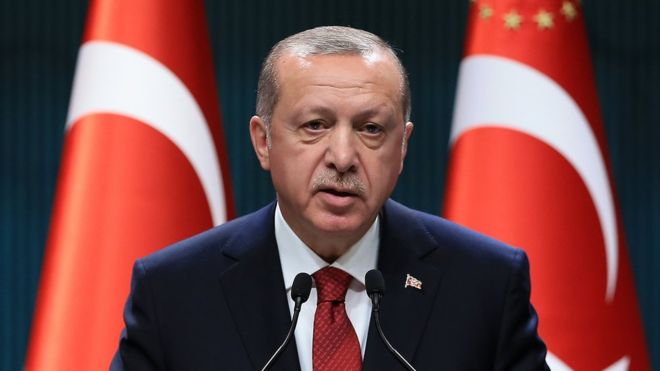President Tayyip Erdogan of Turkey says his country would restore damaged Syrian churches as Christian communities in Northeastern Syria are feeling vulnerable following Turkish incursion.
Erdogan made the promise while speaking with journalists after a meeting with U.S. President, Donald Trump, at the White House on Wednesday.
He also met with some GOP senators.
The Christian Post reports that Erdogan’s meeting with the U.S. officials was meant to clear the air following congressional criticisms of Turkey’s operation in Northeastern Syria.
Turkey launched Operation Peace Spring in October after the U.S announced withdrawal of its troops from the region.
The Operation is believed to be targeted at Kurdish fighters initially backed by the U.S. in the battle against the Islamic State.
The Turkish government accused the Turkish-led Syrian Democratic Forces of being terrorists because of links to Kurdistan Workers’ Party, also known as the P.K.K, The Christian Post said.
An Armenian priest and his son were murdered while another cleric was wounded in an attack claimed by Islamic State this week.
Erdogan assured that his government is “especially sensitive” and has “plans” in place to help Christians remaining on the Syrian side of the border who have seen their churches and sanctuaries destroyed by the violence.
“[They] will see their sanctuaries getting revived and their churches will be reconstructed so that they can go back and start praying there again,” Erdogan said, according to his translator.
“These are the plans that we are making for them. As I said before, the Christian minorities — Aramaic, Catholics, Chaldean, Yazidi — the ones who are living on our side of the border have no problems whatsoever. But the ones remaining on the side of the Syrian territory will see their worshiping practices restored and revived in a special manner.”
The Turkish leader also said the Christian communities are “receiving health care and humanitarian aid in every aspect possible.”
Erdogan told UN General Assembly in September that there was a need for a plan to take control of the large chunk of territory on the Syrian side of the border that runs 18 miles deep by nearly 300 miles long in hopes of resettling millions of Syrian refugees living in Turkey



